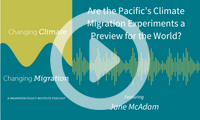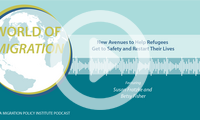Employment-Based Immigration
Recent Activity

What can the rest of the world learn from climate migration legal experiments in the Pacific? This episode of the Changing Climate, Changing Migration podcast features insights from renowned legal scholar Jane McAdam, who directs the Kaldor Centre for International Refugee Law at UNSW.
Marking the launch of MPI’s Global Skills and Talent Initiative, this webcast features senior policymakers and other experts discussing the extent to which labor market needs should shape future immigration policy decisions, and how countries are adjusting—and could adjust—their immigration systems to meet human capital and competitiveness needs.

How could humanitarian migrants with skills and experience use existing work or study visa pathways to fill labor market needs in destination countries? MPI’s Susan Fratzke speaks with Betsy Fisher, U.S. Director of the nonprofit Talent Beyond Boundaries, about complementary pathways as an innovative addition to refugee resettlement and asylum.

On this webinar, speakers discuss the main challenges faced by countries of origin and destination in ensuring mutual benefits through labor migration and strategies moving forward related to migration and development in Guatemala, El Salvador, and Honduras.
Este seminario web, que presenta el lanzamiento de un informe, examina el potencial de Canadá, México y Costa Rica para expandir los programas de trabajadores temporales para los centroamericanos, ofreciendo un medio importante para convertir algunos flujos irregulares en flujos legales.
Pages
Recent Activity
The COVID-19 pandemic’s impacts on mobility in the Middle East and North Africa were immediate and wide-reaching. These include the world’s largest and most sustained repatriation efforts for stranded migrants, halted and reversed irregular journeys, and a reckoning with some countries’ reliance on foreign labor. This report examines how these impacts varied across countries in this highly diverse region, as well as the uneven recovery.























As Europe and the United States Face Similar Migration Challenges, Spain Can Act as a Bridge